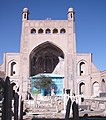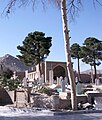Herat
Herāt
هرات | |
|---|---|
City | |
| Country | |
| Province | Herat Province |
| Elevation | 920 m (3,020 ft) |
| Population (2006) | |
| • Total | 397,456 |
| [1] | |
| Time zone | UTC+4:30 (Afghanistan Standard Time) |
Herāt (/hɛˈrɑːt/;[2] Pashto / Template:Lang-fa) is the capital of Herat province in Afghanistan. It is the third largest city of Afghanistan, with a population of about 397,456 as of 2006.[1] It is situated in the valley of the Hari River, which flows from the mountains of central Afghanistan to the Karakum Desert in Turkmenistan. The city is linked with Kandahar and Mazar-e-Sharif via highway 1 or the ring road that stretches across the country. It is also linked to the city of Mashad in Iran through the border town of Islam Qala.
Situated in a fertile area, Herāt dates back to the Avestan times and was traditionally known for its wine. The city has a number of historic sites, including the Herat Citadel and the Mosallah Complex. During the Middle Ages Herāt became one of the important cities of Khorasan, as it was known as the Pearl of Khorasan.[3] In 1717, the city was captured by the Pashtuns and remained under Pashtun control until the Hotaki dynasty was defeated by the Afsharids in 1736. After Nadir Shah's death, Herat became part of the Durrani Empire in 1747. It saw some actions during the 19th century Anglo-Afghan wars. Much of the city has been spared from destructions that occurred in other cities of Afghanistan during the 1978-present wars.
Herāt lies on the ancient trade routes of the Middle East, Central and South Asia. The roads from Herāt to Iran, Turkmenistan, and other parts of Afghanistan are still strategically important. As the gateway to Iran, it collects the highest amount of customs revenue for Afghanistan.[4] The city has an international airport.
History
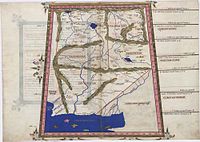
Herat dates back to ancient times, but its exact age remains unknown. During the period of the Achaemenid Empire (ca. 550-330 BC), the surrounding district was known as Haraiva (in Old Persian), and in classical sources the region was correspondingly known as Aria (Areia). In the Zoroastrian Avesta, the district is mentioned as Haroiva. The name of the district and its main town is derived from that of the chief river of the region, the Hari River (Old Iranian Harayu, "Golden Water"), which traverses the district and passes some 5 km (3.1 mi) south of modern Herāt. Hari is mentioned in Sanskrit as yellow or golden color equivalent to Persian Zar meaning Gold (yellow). The naming of a region and its principal town after the main river is a common feature in this part of the world—compare the adjoining districts/rivers/towns of Arachosia and Bactria.
| History of Afghanistan |
|---|
 |
| Timeline |
The district Aria of the Persian Achaemenid Empire is mentioned in the provincial lists that are included in various royal inscriptions, for instance, in the Behistun inscription of Darius I (ca. 520 BC).[5] Representatives from the district are depicted in reliefs, e.g., at the royal Achaemenid tombs of Naqsh-e Rustam and Persepolis. They are wearing Scythian-style dress (with a tunic and trousers tucked into high boots) and a twisted Bashlyk that covers their head, chin and neck.[6]
Hamdallah Mustawfi, composer of the 14th century work The Geographical Part of the Nuzhat-al-Qulub writes that:
"Herāt was the name of one of the chiefs among the followers of the hero Narīmān, and it was he who first founded the city. After it had fallen to ruin Alexander the Great rebuilt it, and the circuit of its walls was 9000 paces."[3]
Herodotus described Herāt as the bread-basket of Central Asia. At the time of Alexander the Great in 330 BC, Aria was obviously an important district. It was administered by a satrap called Satibarzanes, who was one of the three main Persian officials in the East of the Empire, together with the satrap Bessus of Bactria and Barsaentes of Arachosia. In late 330 BC, Alexander captured the Arian capital that was called Artacoana. The town was rebuilt and the citadel was constructed. Afghanistan became part of the Seleucid Empire after Alexander died, which formed an alliance with the Indian Maurya Empire. Historian Strabo writes that the Seleucids later gave the area south of the Hindu Kush to the Mauryas after a treaty was made.
"Alexander took these away from the Aryans and established settlements of his own, but Seleucus Nicator gave them to Sandrocottus (Chandragupta), upon terms of intermarriage and of receiving in exchange 500 elephants."[7]
However, all sources suggest that Herat was predominantly Persian Zoroastrian and there is no evidence of Hinduism making its way into this region. It became part of the Parthian Empire in 167 BC. In the Sasanian period (226-652), Harēv is listed in an inscription on the Ka'ba-i Zartosht at Naqsh-e Rustam; and Hariy is mentioned in the Pahlavi catalogue of the provincial capitals of the empire. In around 430, the town is also listed as having a Christian community, with a Nestorian bishop.[8]
In the last two centuries of Sasanian rule, Aria (Herāt) had great strategic importance in the endless wars between the Sasanians, the Chionites and the Hephthalites who had been settled in modern northern Afghanistan since the late 4th century.
Islamization

At the time of the Arab invasion in the middle of the 7th century, the Sasanian central power seemed already largely nominal in the province in contrast with the role of the Hephthalites tribal lords, who were settled in the Herat region and in the neighboring districts, mainly in pastoral Bādghis and in Qohestān. It must be underlined, however, that Herat remained one of the three Sasanian mint centers in the east, the other two being Balkh and Marv. The Hephthalites from Herat and some unidentified Turks opposed the Arab forces in a battle of Qohestān in 651-52 AD, trying to block their advance on Nishāpur, but they were defeated
When the Arab armies appeared in Khorāsān in the 650s AD, Herāt was counted among the twelve capital towns of the Sasanian Empire. The Arab army under the general command of Ahnaf ibn Qais in its conquest of Khorāsān in 652 seems to have avoided Herāt, but it can be assumed that the city submitted to the Arabs, since shortly afterwards an Arab governor is mentioned there. A treaty was drawn in which the regions of Bādghis and Bushanj were included. As did many other places in Khorāsān, Herāt rebelled and had to be re-conquered several times.[9] In 702 AD Yzid ibn al-Muhallab defeated certain Arab rebels, followers of Ibn al-Ash'ath, and forced them out of Herat. The city was the scene of conflicts between different groups of Muslims and Arab tribes in the disorders leading to the establishment of the Abbasid Caliphate. Herat was also a centre of the followers of Ustadh Sis.
In 870 AD, Yaqub ibn Layth Saffari, a local ruler of the Saffarid dynasty conquered Herat and the rest of the nearby regions in the name of Islam.
...Arab armies carrying the banner of Islam came out of the west to defeat the Sasanians in 642 AD and then they marched with confidence to the east. On the western periphery of the Afghan area the princes of Herat and Seistan gave way to rule by Arab governors but in the east, in the mountains, cities submitted only to rise in revolt and the hastily converted returned to their old beliefs once the armies passed. The harshness and avariciousness of Arab rule produced such unrest, however, that once the waning power of the Caliphate became apparent, native rulers once again established themselves independent. Among these the Saffarids of Seistan shone briefly in the Afghan area. The fanatic founder of this dynasty, the coppersmith’s apprentice Yaqub ibn Layth Saffari, came forth from his capital at Zaranj in 870 AD and marched through Bost, Kandahar, Ghazni, Kabul, Bamiyan, Balkh and Herat, conquering in the name of Islam.[10]
Pearl of Khorasan
The region of Herāt was under the rule of King Nuh III, the seventh of the Samanid line—at the time of Sebük Tigin and his older son, Mahmud of Ghazni.[11] The governor of Herāt was a noble by the name of Faik, who was appointed by Nuh III. It is said that Faik was a powerful, but insubordinate governor of Nuh III; and had been punished by Nuh III. Faik made overtures to Bogra Khan and Ughar Khan of Khorasan. Bogra Khan answered Faik's call, came to Herāt and became its ruler. The Samanids fled, betrayed at the hands of Faik to whom the defence of Herāt had been entrusted by Nuh III.[11] In 994, Nuh III invited Alp Tigin to come to his aid. Alp Tigin, along with Mahmud of Ghazni, defeated Faik and annexed Herāt, Nishapur and Tous.[11]

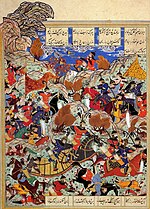

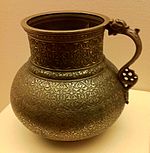
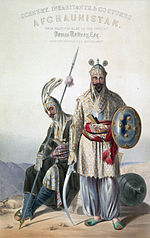
Herāt was a great trading centre strategically located on trade routes from Mediterranean Sea to India or to China. The city was noted for its textiles during the Abbasid Caliphate, according to many references in the geographers. Herāt also had many learned sons such as Ansārī. The city is described by Estakhri and Ibn Hawqal in the 10th century as a prosperous town surrounded by strong walls with plenty of water sources, extensive suburbs, an inner citadel, a congregational mosque, and four gates, each gate opening to a thriving market place. The government building was outside the city at a distance of about a mile in a place called Khorāsānābād. A church was still visible in the countryside northeast of the town on the road to Balkh, and farther away on a hilltop stood a flourishing fire temple, called Sereshk, or Arshak according to Mustawfi.[3][13][14][15][16]
Herat was a part of the Taherid dominion in Khorāsān until the rise of the Saffarids in Sistān under Ya'qub-i Laith in 861, who, in 862, started launching raids on Herat before besieging and capturing it on 16 August 867, and again in 872. The Saffarids succeeded in expelling the Taherids from Khorasan in 873.
The Sāmānid dynasty was established in Transoxiana by three brothers, Nuh, Yahyā, and Ahmad. Ahmad Sāmāni opened the way for the Samanid dynasty to the conquest of Khorāsān, including Herāt, which they were to rule for one century. The centralized Samanid administration served as a model for later dynasties. The Samanid power was destroyed in 999 by the Qarakhanids, who were advancing on Transoxiana from the northeast, and by the Ghaznavids, former Samanid retainers, attacking from the southeast.
Sultan Maḥmud of Ghazni officially took control of Khorāsān in 998. Herat was one of the six Ghaznavid mints in the region. In 1040, Herat was captured by the Seljuk Empire. Yet, in 1175, it was captured by the Ghurids of Ghor and then came under the Khawarazm Empire in 1214. According to the account of Mustawfi, Herat flourished especially under the Ghurid dynasty in the 12th century. Mustawfi reported that there were "359 colleges in Herat, 12,000 shops all fully occupied, 6,000 bath-houses; besides caravanserais and mills, also a darwish convent and a fire temple". There were about 444,000 houses occupied by a settled population. The men were described as "warlike and carry arms", and they were Sunni Muslims.[3] The great mosque of Herāt was built by Ghiyas ad-Din Ghori in 1201. In this period Herāt became an important center for the production of metal goods, especially in bronze, often decorated with elaborate inlays in precious metals.
Herāt was invaded and destroyed by Genghis Khan's Mongol army in 1221. The city was destroyed a second time and remained in ruins from 1222 to about 1236. In 1244 a local prince Shams al-Din Kart was named ruler of Herāt by the Mongol governor of Khorāsān and in 1255 he was confirmed in his rule by the founder of the Il-Khan dynasty Hulagu. Shams al-Din founded a new dynasty and his successors, especially Fakhr-al-Din and Ghiyath al-Din, built many mosques and other buildings. The members of this dynasty were great patrons of literature and the arts. By this time Herāt became known as the pearl of Khorasan.
"If any one ask thee which is the pleasantest of cities, Thou mayest answer him aright that it is Herāt. For the world is like the sea, and the province of Khurāsān like a pearl-oyster therein, The city of Herāt being as the pearl in the middle of the oyster."[3]
— Rumi, 1207-1273 A.D.
Timur took Herat in 1380 and he brought the Kartid dynasty to an end a few years later, but the city reached its greatest glory under the Timurid princes, especially Sultan Husayn Bayqara who ruled Herat from 1469 to 912/1506. His chief minister, the poet and author in Persian and Turkish, Mir Ali-Shir Nava'i was a great builder and patron of the arts. Under the Timurids, Herat assumed the role of the main capital of an empire that extended in the West as far as central Persia. As the capital of the Timurid empire, it boasted many fine religious buildings and was famous for its sumptuous court life and musical performance and its tradition of miniature paintings. On the whole, the period was one of relative stability, prosperity, and development of economy and cultural activities. It began with the nomination of Shahrokh, the youngest son of Timur, as governor of Herat in 1397. The reign of Shahrokh in Herat was marked by intense royal patronage, building activities, and promotion of manufacturing and trade, especially through the restoration and enlargement of the Herat’s bāzār. The present Mosalla Complex, and many buildings such as the madrasa of Goharshad, Ali Shir mahāl, many gardens, and others, date from this time. The village of Gazargah, over two km northeast of Herat, contained a shrine which was enlarged and embellished under the Timurids. The tomb of the poet and mystic Khwājah Abdullāh Ansārī (d. 1088), was first rebuilt by Shahrokh about 1425, and other famous men were buried in the shrine area. Herat was shortly captured by Kara Koyunlu between 1458-1459.[17]
In 1507 Herat was occupied by the Uzbeks but after much fighting the city was taken by Shah Isma'il, the founder of the Safavid dynasty, in 1510 and the Shamlu Qizilbash assumed the governorship of the area. Under the Safavids, Herat was again relegated to the position of a provincial capital, albeit one of a particular importance. At the death of Shah Isma'il the Uzbeks again took Herat and held it until Shah Tahmasp retook it in 1528. Several times later for brief periods the Uzbeks held the city but the Safavids ruled it most of the time until the revolt of the Ghilzai and Abdali Afghans in 1716. Several Safavid expeditions to retake the city failed, and the Abdalis remained in possession of the city until 1736 when they submitted to Nader Shah. In 1747 the nephew of Nader Shah, one Aliqoli Khan, revolted in Herat but after Nader's death in that year Herat fell under Afghan rule.
Modern history
From 1725 to 1736 Herat was controlled by the Hotaki Pashtuns until King Nader Shah's of Persia retook the city and destroyed the Hotakis for good. After Nader Shah's death in 1747, Ahmad Shah Durrani took possession of the city and became part of the Durrani Empire. Ahmad Shah Durrani's father, Zaman Khan, was the governor of Herat province before the Ghilzai's conquer of the region. Zaman Khan and several of his family members were killed while his son Ahmad Khan (Durrani) and Zulfiqar Khan were taken as prisoners to Kandahar in the south.

In 1816 the Persians captured the city but abandoned it shorly after. Two years later a second Persian campaign against the city was defeated at the Battle of Kafir Qala.
In 1824, Herat became independent for several years when the Afghan empire was split between the Durranis and the Barakzais. Qajars of Persia tried to take city from the Durranis in 1838 and again in 1856; both times the British helped to repel the Persians, the second time through the Anglo-Persian War. The city fell to Dost Mohammad Khan of the Barakzai dynasty in 1863. Most of the Musallah complex in Herat was cleared in 1885 by the British army to get a good line of sight for their artillery against Russian invaders who never came. This was but one small sidetrack in the Great Game, a century-long conflict between the British Empire and the Russian Empire in 19th century.


In the 1960s, engineers from the United States built Herat Airport, which was used by the Soviet forces during the Democratic Republic of Afghanistan in the 1980s. Even before the Soviet invasion at the end of 1979, there was a substantial presence of Soviet advisors in the city with their families. Between March 10 to 20 in 1979, Afghan army in Herāt under the control of Ismail Khan mutinied. Reprisals by the Afghan government followed, and between 3,000 and 5,000 people were killed.[18] The city itself was recaptured with tanks and airborne forces.
Ismail Khan became the leading mujahideen commander in Herāt. After the departure of the Soviets, he became governor of Herat Province. In September 1995 the city was captured by the Taliban without much resistance, forcing Ismail Khan to flee. However, after the U.S. invasion of Afghanistan, on November 12, 2001, it was liberated from the Taliban by forces loyal to the Northern Alliance and Ismail Khan returned to power (see Battle of Herat). In 2004, Mirwais Sadiq, Aviation Minister of Afghanistan and the son of Ismail Khan, was ambushed and killed in Herāt by a local rival group. More than 200 people were arrested under suspicion of involvement.[19]
Herāt is now fully under the control of Afghanistan's new central government, led by Hamid Karzai, who was initially backed by the United States. The Afghan National Army and the Afghan National Police provide security in the city as well as the whole province. There is also presence of the International Security Assistance Force (ISAF) forces in the area, which is led by Italy and assisting the Military of Afghanistan. Herat was one of the first seven areas that transitioned security responsibility from NATO to Afghanistan. On July 21, 2011, Afghan security forces assumed lead security responsibility from NATO. On the occasion, Minister of Defense Wardak told the audience, “this is our national responsibility to take over our security and defend our country."
Due to their close connection, Iran began investing in the development of Herat's power, economy and education sectors. As a result, the city now enjoys 24-hour electricity, paved roads, and a higher sense of security.[20] In the meantime, the United States built a consulate in Herat to help further strengthen its relations with Afghanistan. In addition to the usual services, the consulate works with the local officials on development projects and with security issues in the region.[21]
Climate
| Herāt | ||||||||||||||||||||||||||||||||||||||||||||||||||||||||||||
|---|---|---|---|---|---|---|---|---|---|---|---|---|---|---|---|---|---|---|---|---|---|---|---|---|---|---|---|---|---|---|---|---|---|---|---|---|---|---|---|---|---|---|---|---|---|---|---|---|---|---|---|---|---|---|---|---|---|---|---|---|
| Climate chart (explanation) | ||||||||||||||||||||||||||||||||||||||||||||||||||||||||||||
| ||||||||||||||||||||||||||||||||||||||||||||||||||||||||||||
| ||||||||||||||||||||||||||||||||||||||||||||||||||||||||||||
Herāt has a cold semi-arid climate (Köppen climate classification BSk).
Precipitation is very low, and mostly falls in winter. Although Herāt is approximately 240 m (790 ft) lower than Kandahar, the summer climate is more temperate, and the climate throughout the year is far from disagreeable. From May to September, the wind blows from the northwest with great force.
The winter is tolerably mild; snow melts as it falls, and even on the mountains does not lie long. Three years out of four it does not freeze hard enough for the people to store ice. The eastern reaches of the Hari River, including the rapids, are frozen hard in the winter, and people travel on it as on a road.
| Climate data for Herāt | |||||||||||||
|---|---|---|---|---|---|---|---|---|---|---|---|---|---|
| Month | Jan | Feb | Mar | Apr | May | Jun | Jul | Aug | Sep | Oct | Nov | Dec | Year |
| Record high °C (°F) | 24.4 (75.9) |
27.6 (81.7) |
31.0 (87.8) |
37.8 (100.0) |
39.7 (103.5) |
44.6 (112.3) |
46.0 (114.8) |
42.7 (108.9) |
39.3 (102.7) |
37.0 (98.6) |
30.0 (86.0) |
26.5 (79.7) |
46.0 (114.8) |
| Mean daily maximum °C (°F) | 9.1 (48.4) |
11.9 (53.4) |
17.9 (64.2) |
24.0 (75.2) |
29.6 (85.3) |
35.0 (95.0) |
36.7 (98.1) |
35.1 (95.2) |
31.4 (88.5) |
25.0 (77.0) |
17.8 (64.0) |
12.0 (53.6) |
23.8 (74.8) |
| Daily mean °C (°F) | 2.9 (37.2) |
5.5 (41.9) |
10.2 (50.4) |
16.3 (61.3) |
22.1 (71.8) |
27.2 (81.0) |
29.8 (85.6) |
28.0 (82.4) |
22.9 (73.2) |
16.1 (61.0) |
8.8 (47.8) |
4.7 (40.5) |
16.2 (61.2) |
| Mean daily minimum °C (°F) | −2.9 (26.8) |
−0.6 (30.9) |
3.8 (38.8) |
9.1 (48.4) |
13.3 (55.9) |
18.2 (64.8) |
21.2 (70.2) |
19.2 (66.6) |
13.2 (55.8) |
7.4 (45.3) |
1.0 (33.8) |
−1.4 (29.5) |
8.5 (47.2) |
| Record low °C (°F) | −26.7 (−16.1) |
−20.5 (−4.9) |
−13.3 (8.1) |
−2.3 (27.9) |
0.8 (33.4) |
9.7 (49.5) |
14.7 (58.5) |
8.4 (47.1) |
1.3 (34.3) |
−5.6 (21.9) |
−12.8 (9.0) |
−22.7 (−8.9) |
−26.7 (−16.1) |
| Average precipitation mm (inches) | 51.6 (2.03) |
44.8 (1.76) |
55.1 (2.17) |
29.2 (1.15) |
9.8 (0.39) |
0.0 (0.0) |
0.0 (0.0) |
0.0 (0.0) |
0.0 (0.0) |
1.7 (0.07) |
10.9 (0.43) |
35.8 (1.41) |
238.9 (9.41) |
| Average rainy days | 6 | 8 | 8 | 7 | 2 | 0 | 0 | 0 | 0 | 1 | 3 | 5 | 40 |
| Average snowy days | 2 | 2 | 1 | 0 | 0 | 0 | 0 | 0 | 0 | 0 | 0 | 1 | 6 |
| Average relative humidity (%) | 72 | 69 | 62 | 56 | 45 | 34 | 30 | 30 | 34 | 42 | 55 | 67 | 50 |
| Mean monthly sunshine hours | 149.3 | 153.5 | 202.5 | 235.7 | 329.6 | 362.6 | 378.6 | 344.8 | 323.2 | 274.0 | 235.0 | 143.1 | 3,131.9 |
| Source: NOAA (1959-1983) [22] | |||||||||||||
Demography
The population of Herat numbers approximately 397,500.[23]
The exact figures on ethnic groups are not available but most sources state that Persian-speaking Tajiks are the main inhabitants of the city, and are roughly the same as the Persians of eastern Iran.[24][25] According to a 2003 National Geographic suggested estimate, Tajiks form about 40% of the city population. Pashtuns20% followed by Hazaras at 20%, [[Uzbek people|Uzbeks] and Turkmens at 20%.[26]
The native language of Herat (known as Herātī) belongs to the Khorāsānī cluster within Persian and is akin to the Persian dialects of eastern Iran, notably those of Mashhad and Khorasan Province.
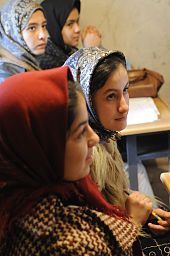
Notable people from Herat
- Khwājah Abdullāh Ansārī, a famous Persian poet of the 11th century
- Nūr ud-Dīn Jāmī, a famous Persian Sufi poet of the 15th century
- Nizām ud-Din ʿAlī Shīr Navā'ī, famous poet and politician of the Timurid era
- Ustād Kamāl ud-Dīn Behzād, the greatest of the medieval Persian painters
- Gowharšād, wife of Shāhrūkh Mīrzā
- Mīrzā Shāhrūkh bin Tīmur Barlas, Emperor of the Timurid dynasty of Herāt
- Mīrzā Husseyn Bāyqarāh, Emperor of the Timurid dynasty of Herāt
- Shāh Abbās The Great, Emperor of Safavid Persia
- Abbās Qullī Khān Shāmlū, Safavid Governor of Herat Province (1812)
- Latīf Nāzemī, famous poet of modern times
- Sultan Jan, ex-ruler of Herat.
- Ismail Khan, former governor of Herat Province and Minister of Water and Energy
Transport
Air
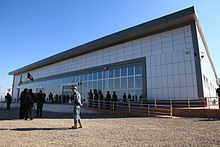
Herat International Airport was built by engineers from the United States in the 1960s and was used by the Soviet Armed Forces during their 1980s war with the Afghan mujahideen forces. It was bombed in late 2001 when the US-led Operation Enduring Freedom began to remove the Taliban government from power. It has been rebuilt in the last decade and is scheduled to be turned into Herat International Airport in the near future. The runway of the airport has been extended and upraded.
Rail
In 2007, Afghanistan and neighboring Iran finalized an agreement for the establishment of a rail service between the two countries. Construction of the 191 km (119 mi) railway, from Khaf in Iran to Herāt, is in progress on the Iranian side of the border.[27] It is expected to be completed by the end of 2012. There is also the prospect of an extension across Afghanistan to Sher Khan Bandar. See railway stations in Afghanistan.
Places of interest
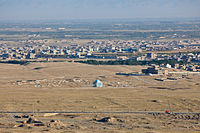




- Neighborhoods
- Shahr-e Naw (Downtown)
- Welayat (Office of the governor)
- Qol-Ordue (Army's HQ)
- Farqa (Army's HQ)
- Darwaze Khosh
- Chaharsu
- Pul-e rangine
- Sufi-abad
- New-abad
- Pul-e malaan
- Thakhte Safar
- Howz-e-Karbas
- Baramaan
- Darwaze-ye Qandahar
- Darwaze-ye Iraq
- Darwaze Az Kordestan
- Parks
- Park-e Taraki
- Park-e Millat
- Khane-ye Jihad Park
- Monuments
- Herat Citadel (Qala Ikhtyaruddin or Arg)
- Musallah Complex
Of the more than dozen minarets that once stood in Herāt, many have been toppled from war and neglect over the past century. Recently, however, everyday traffic threatens many of the remaining unique towers by shaking the very foundations they stand on. Cars and trucks that drive on a road encircling the ancient city rumble the ground every time they pass these historic structures. UNESCO personnel and Afghan authorities have been working to stabilize the Fifth Minaret.[28][29]
- Museums
- Herat Museum, located inside the Herat Citadel
- Jihad Museum
- Mausoleums and tombs
- Mausoleum of Queen Goharshad
- Mausoleum of Khwajah Abdullah Ansari
- Tomb of Jami
- Tomb of khaje Qaltan
- Mausoleum of Mirwais Sadiq
- Jewish cemetery - there once existed an ancient Jewish community in the city. Its remnants are a cemetery and a ruined shrine.[30]
- Mosques
- Masjid-e Jame (Friday Mosque of Herat)
- Gazargah Sharif
- Khalghe Sharif
- Shah Zahdahe
- Hotels
- Serena Hotel (coming soon)
- Diamond Hotel
- Marcopolo Hotel
- Stadiums
- Herat Stadium
- Universities
Gallery
- Images of Herāt
-
Landmark at a traffic circle
-
Mausoleum of Mirwais Sadiq Khan, son of Ismail Khan, who was killed in 2004 in clashes with the Afghan National Army
-
A commercial center, which is the tallest building in the city
-
Shopping center
-
Pol-e Mālān, a historical bridge
-
Pillar of Mosallah Complex
-
Khwājah Abdullāh Ansārī shrine, a Sufi of the 11th century
-
Gazar Gah cemetery
-
Tomb of Jāmi, a poet of the 15th century
-
The Jewish cemetery
Herāt in fiction
- The beginning of Khaled Hosseini's 2007 novel A Thousand Splendid Suns is set in and around Herāt.
- Salman Rushdie's novel The Enchantress of Florence makes frequent reference to events in Herāt in the Middle Ages.
See also
References
- ^ a b "B. Demography and Population" (PDF). Afghanistan Statistical Yearbook 2006, Central Statistics Office. Ministry of Rural Rehabilitation and Development. Retrieved 2011-01-12.
- ^ http://www.merriam-webster.com/dictionary/herat
- ^ a b c d e Ḥamd-Allāh Mustawfī of Qazwīn (1340). "The Geographical Part of the NUZHAT-AL-QULŪB". Translated by Guy Le Strange. Packard Humanities Institute. Retrieved 2011-08-19.
- ^ "Bomb blast hits west Afghan city". BBC News. August 3, 2009. Retrieved March 26, 2010.
- ^ Translated by Herbert Cushing Tolman. "The Behistan Inscription of King Darius". Vanderbilt University, Nashville, Tennessee.
- ^ W. J. Vogelsang, 2003, HERAT ii. HISTORY, PRE-ISLAMIC PERIOD, Encyclopaedia Iranica.
- ^ An Historical Guide to Kabul - The Story of Kabul] by Nancy Hatch Dupree / Aḥmad ʻAlī Kuhzād.
- ^ The earliest recorded date of a bishop in Herat is 424. http://www.nestorian.org/location_of_nestorian_bishops.html
- ^ Abu Ja’far Muḥammad ibn Jarir Ṭabari, Taʾrikh al-rosul wa’l-moluk, pp. 2904-6
- ^ Dupree, Nancy Hatch (1970). An Historical Guide to Afghanistan. Vol. First Edition. Kabul: Afghan Air Authority, Afghan Tourist Organization. p. 492. Retrieved 2012-06-17.
{{cite book}}: Cite has empty unknown parameter:|coauthors=(help) - ^ a b c Skrine, Francis Henry; Ross, Edward Denison (2004). The heart of Asia: a history of Russian Turkestan and the Central Asian Khanates from the earliest times. Routledge. p. 117. ISBN 0-7007-1017-5.
- ^ Musée du Louvre, Calligraphy in Islamic Art
- ^ The Encyclopaedia of Islam, Brill Publishers, Vol.3: H-Iram, 1986, Leiden, pp. 177
- ^ Eṣṭaḵri, pp. 263-65, tr. pp. 277-82
- ^ Ibn Ḥawqal, pp. 437-39, tr. pp. 424;
- ^ Moqaddasi (Maqdesi), Aḥsan al-taqāsim fi maʿrifat al-aqālim, ed. M. J. de Goeje, Leiden, 1906, p. 307;
- ^ http://www.azerbaijans.com/content_369_tr.html
- ^ Resisting Rebellion: The History and Politics of Counterinsurgency By Anthony James Joes
- ^ "More arrests after Herat killing". London: BBC News. 2004-03-25.
- ^ Motlagh, Jason.Iran's Spending Spree in Afghanistan. TIME. Wednesday May 20, 2009. Retrieved on May 24, 2009.
- ^ "U.S. Ambassador Karl W. Eikenberry Remarks at the Lease-Signing Ceremony for U.S. Consulate Herat"
- ^ "Herat Climate Normals 1959-1983". National Oceanic and Atmospheric Administration. Retrieved December 25, 2012.
- ^ UNDSS Provincial Profile, Afghanistan's "Ministry of Rural Rehabilitation and development (MRRD)", 2009
- ^ H. F. Schurmann, The Mongols of Afghanistan: an Ethnography of the Moghols and Related Peoples of Afghanistan. The Hague: Mouton, 1962: Jstor.org; p. 75: "... the Tajiks of Western Afghanistan [are] roughly the same as the Khûrâsânî Persians on the other side of the line ..."
- ^ Afghanistan's Provinces– Herat at NPS.edu
- ^ "2003 National Geographic Population Map" (PDF). Thomas Gouttierre, Center For Afghanistan Studies, University of Nebraska at Omaha; Matthew S. Baker, Stratfor. National Geographic Society. 2003. Retrieved 2011-04-11.
- ^ Opening up Afghan trade route to Iran Railway Gazette International 2008-01-29
- ^ Bendeich, Mark (June 25, 2007). "Cars, Not War, Threaten Afghan Minarets". Islam Online. Retrieved 2009-09-24.
- ^ Podelco, Grant (July 18, 2005). "Afghanistan: Race To Preserve Historic Minarets of Herat, Jam". Radio Free Europe/Radio Liberty. Retrieved 2009-09-24.
- ^ A good description of the sites, including former afgahani jews who lived there, and of some locals, could be seen at "Quest for the lost tribes", a film by Simcha Jacobovici.
This article incorporates text from a publication now in the public domain: Chisholm, Hugh, ed. (1911). Encyclopædia Britannica (11th ed.). Cambridge University Press. {{cite encyclopedia}}: Missing or empty |title= (help)
Further reading
- Published in the 19th century
- Jedidiah Morse; Richard C. Morse (1823), "Herat", A New Universal Gazetteer (4th ed.), New Haven: S. Converse
{{citation}}: External link in|chapterurl=|chapterurl=ignored (|chapter-url=suggested) (help)
- Narcisse Perrin (1842), "Hérat", L'Afghanistan (in French), Paris: Bertrand
{{citation}}: External link in|chapterurl=|chapterurl=ignored (|chapter-url=suggested) (help)
- Edward Balfour (1885), "Herat", Cyclopaedia of India (3rd ed.), London: B. Quaritch
{{citation}}: External link in|chapterurl=|chapterurl=ignored (|chapter-url=suggested) (help)
- Published in the 20th century
- "Herat", The Encyclopaedia Britannica (11th ed.), New York: Encyclopaedia Britannica, 1910, OCLC 14782424
{{citation}}: External link in|chapterurl=|chapterurl=ignored (|chapter-url=suggested) (help)
- Published in the 21st century
- C. Edmund Bosworth, ed. (2007). "Herat". Historic Cities of the Islamic World. Leiden: Koninklijke Brill.
- Michael R.T. Dumper; Bruce E. Stanley, eds. (2008), "Herat", Cities of the Middle East and North Africa, Santa Barbara, USA: ABC-CLIO
- "Herat". Grove Encyclopedia of Islamic Art & Architecture. Oxford University Press. 2009.
External links
- Video: Herat After Transition, with Voiceover by Natochannel
- Heratonline.com: Information and news about Herāt
- Detailed map of Herāt city
- Map of Herāt and surroundings in 1942, Perry-Castañeda Library Map Collection, University of Texas, Austin
- Explore Herat with Google Earth on Global Heritage Network
- Herat a leading city in Afghanistan
- Photo Gallery of Herat
- Three Women of Herat: A Memoir of life, Love and Friendship in Afghanistan" by Veronica Doubleday
- Ethnomusicological Research in Afghanistan:
- ArchNet.org. "Herat". Cambridge, Massachusetts, USA: MIT School of Architecture and Planning.







